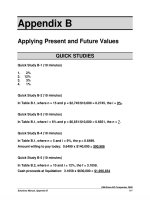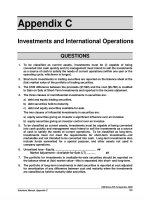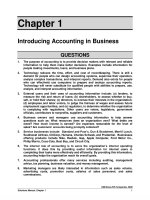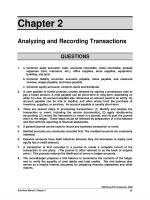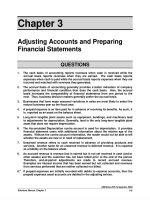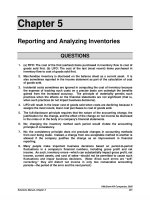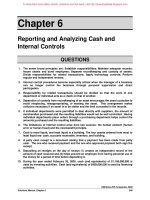Solution manual financial accounting by valix ch16 20
Bạn đang xem bản rút gọn của tài liệu. Xem và tải ngay bản đầy đủ của tài liệu tại đây (246.38 KB, 70 trang )
210
CHAPTER 16
Problem 16-1
1.
2.
3.
4.
5.
C
D
D
D
B
Problem 16-2
Cash paid for land and old building
Removal of old building
Payment to tenants of old building to vacate premises
Architect fee
Building permit
Fee for title search
Survey before construction
Excavation
Cost of new building constructed
Assessment fee
Cost of grading, leveling and landfill
Driveways and walks
Temporary quarters for construction crew
Temporary building to house tools and materials
Cost of construction changes
Land
1,000,000
50,000
15,000
Building
200,000
30,000
10,000
20,000
100,000
6,000,000
5,000
45,000
_________
1,145,000
40,000
80,000
60,000
50,000
6,560,000
Note: The cost of replacing windows is treated as expense.
Problem 16-3
Land
Land
improvement
Cost of land
Legal fees
Payment of mortgage
Payment of taxes
Cost of razing building
Proceeds from sale of materials
Grading and drainage
Architect fee
Payment to contractor
Interest cost
Driveway and parking lot
Cost of trees, shrubs and other landscaping
Cost of installing lights in parking lot
Premium for insurance
2,000,000
10,000
50,000
20,000
30,000
(
15,000
Building
5,000)
200,000
8,000,000
300,000
_______
2,120,000
25,000
8,525,000
40,000
55,000
5,000
_______
100,000
The payment for medical bills and the cost of open house party are outright expenses
because they are not a necessary cost of acquiring the land and building.
211
Problem 16-4
Office
Land
improvements
Purchase price
Materials
Excavation
Labor
Remodeling
Cash discounts
Supervision
Compensation insurance
Clerical and other expenses
Paving of streets
Plans and specifications
Legal cost - land
1,300,000
Factory
building
building
Land
700,000
3,200,000
100,000
2,500,000
200,000
(
60,000)
30,000
50,000
30,000
40,000
10,000
1,310,000
________
900,000
150,000
________
6,000,000
______
40,000
1. The imputed interest on corporation’s own money is not capitalizable.
2. The payment of claim for injuries not covered by insurance and the legal cost of injury
claim are treated as expense.
3. Saving on construction is not recognized.
Problem 16-5
Taxes in arrears
Payment for land
Demolition of old building
Total cost of land
50,000
1,000,000
100,000
1,150,000
Architect fee
Payment to city hall
Contract price
Safety fence around construction site
Safety inspection on building
30,000
Removal of safety fence
Total cost of factory building
230,000
120,000
5,000,000
35,000
20,000
5,435,000
Problem 16-6
Purchase price
Title clearance fee
Cost of razing old building
Scrap value of old building
Total cost of land
Construction cost of new building
3,000,000
50,000
100,000
( 10,000)
3,140,000
8,000,000
212
Problem 16-7
Purchase price
4,000,000
Remodeling
Salvage materials
Grading, leveling and other permanent improvement
Repairs
Land
Building
1,000,000
150,000
5,000)
(
50,000
________
1,050,000
10,000
4,155,000
The repairs are capitalized because they are necessary prior to the occupancy and
intended use of the building.
Problem 16-8
Land
Machinery
Fair value
Repairs
Remodeling
Invoice price
Discount
Base
1,500,000
_________
1,500,000
Building
5,000,000
200,000
300,000
1,000,000
(
20,000)
_________
50,000
5,500,000
1,030,000
The driveway and parking lot are charged to land improvements.
Problem 16-9
Land
Machinery
Fair value
1,500,000
Repairs
Special tax assessment
Platform
Remodeling
Purchase price
Discount
Freight
Installation
1,500,000
Building
4,000,000
200,000
30,000
70,000
400,000
(
_________
1,530,000
_________
4,600,000
800,000
40,000)
20,000
30,000
2,380,000
Problem 16-10
Purchase price
Commission
2,000,000
100,000
Contract price
6,000,000
Plans, specification
Legal fees
Title guarantee
Cost of razing old building
Salvage value of materials
Cost of land
50,000
10,000
75,000
(
5,000)
2,230,000
and blueprint
Architectural fee
Cost of new building
100,000
250,000
6,350,000
213
Problem 16-11
Land
Leasehold
Building improvements
Machinery
Balances, Jan. 1
1,000,000
Acquisition of land - #621:
Purchase price
Commission
Clearing cost
Sale of timber and gravel
Acquisition of land - #622:
Purchase price
Cost of demolition
New building:
Construction cost
Excavation fee
Architectural design
Building permit
Improvements:
Electrical work
Construction extension
(800,000 x 1/2)
Improvements on office space
Purchase of new machine:
Invoice price
Freight
Unloading charge
Balances, December 31
2,800,000
1,500,000
4,000,000
500,000
3,000,000
60,000
15,000
(
5,000)
4,000,000
300,000
5,000,000
50,000
150,000
40,000
350,000
400,000
650,000
_________
8,870,000
1,750,000
20,000
_________
_________
__ 30,000
9,240,000
1,900,000
The third tract of land should be presented as current asset because it was “classified as
held for sale”.
Problem 16-12
Land
Land
improvements
Building
Machinery
Balances, Jan. 1
1,500,000
Land acquired
Issuance of share capital:
3,500,000
1,250,000
900,000
7,000,000
12/36 x 4,500,000
24/36 x 4,500,000
New machinery
New parking lot, street and
sidewalk
Machinery sold
Balances, Dec. 31
4,400,000
1,500,000
3,000,000
3,400,000
________
6,250,000
750,000
________
_________
( 500,000)
1,650,000
10,000,000
The “assessed values” do not represent the fair values of the land and building but are
used in allocating the market value of the share capital.
214
Problem 16-13
Invoice price
Cash discount
Freight
Installation cost
Testing cost
Problem 16-14
3,000,000 Invoice cost
4,000,000
( 150,000) Discount (5% x 4,000,000)
( 200,000)
50,000
Transportation
40,000
30,000
Installation
100,000
20,000
Trial run-salary of engineer
50,000
2,950,000
Cash allowance
(
60,000)
3,930,000
Problem 16-15
Cost paid (896,000 – 96,000)
800,000
Cost of transporting machine
Installation cost
Testing cost
Safety rails and platform
Water device
Cost of adjustment
Estimated dismantling cost
Total cost of machine
30,000
50,000
40,000
60,000
80,000
75,000
65,000
1,200,000
Note that the estimated dismantling cost is capitalized because the company has a
present obligation as required by contract. In the absence of a present obligation,
the estimated dismantling cost is not capitalized.
Problem 16-16
Second hand market value
Overhaul and repairs
Installation
Testing
Hauling
Safety device
2,400,000
150,000
80,000
110,000
10,000
250,000
3,000,000
Problem 16-17
1. Materials
Labor
Installation
600,000
400,000
60,000
Trial run
Discount
Overhead
(
30,000
40,000)
150,000
1,200,000
2. Adjusting entries:
1. Loss on retirement of old machinery
Machinery (20,000 – 14,000)
6,000
6,000
215
2. Purchase discount
Machinery
40,000
3. Machinery
Factory overhead
150,000
4. Profit on construction
Machinery
100,000
40,000
150,000
100,000
5. Tools
Machinery
90,000
6. Depreciation – tools
Tools (90,000 / 3 x 4/12)
10,000
7. Machinery
Accumulated depreciation
Depreciation – machinery
90,000
10,000
128,600
40,000
88,600
Depreciation recorded
Correct depreciation (1,200,000 / 10 x 4/12)
Overdepreciation
128,600
40,000
88,600
Problem 16-18
Initial design fee
Executive chairs and desks
Storm windows and installation
Installation of automatic door opening system
Overhead crane
Total capital expenditures
150,000
200,000
500,000
200,000
350,000
1,400,000
Problem 16-19
1. Accumulated depreciation
Loss on retirement of building
Building
Building
Cash
Depreciation (8,100,000 / 20)
400,000
1,600,000
2,000,000
2,500,000
2,500,000
405,000
Accumulated depreciation
405,000
Building (9,000,000 + 2,500,000 – 2,000,000)
9,500,000
Accumulated depreciation (1,800,000 – 400,000)
1,400,000
Book value
2. Accumulated depreciation (1,960,000 x 20%)
Loss on retirement of building
Building (2,500,000 x .784)
8,100,000
392,000
1,568,000
1,960,000
216
Building
Cash
Depreciation (8,132,000 / 20)
Accumulated depreciation
2,500,000
2,500,000
406,600
406,600
Building (9,000,000 – 1,960,000 + 2,500,000)
9,540,000
Accumulated depreciation (1,800,000 – 392,000)
1,408,000
Book value
8,132,000
Problem 16-20
a. Annual depreciation (8,400,000 / 30)
280,000
Age of building (7,000,000 / 280,000)
b. Building
Cash
25 years
2,500,000
2,500,000
c. Building (8,400,000 + 2,500,000)
10,900,000
Less: Accumulated depreciation
Book value
d. Depreciation (3,900,000 / 15)
Accumulated depreciation
7,000,000
3,900,000
260,000
260,000
Original life
30
Less: Expired life
Remaining useful life, beginning of current year
25
Add: Extension in life
Revised useful life
10
5
15
Problem 16-21
1. Building
Cash
2. Depreciation
Accumulated depreciation
3. Building
Cash
Accumulated depreciation (2,500,000 / 50 x 2)
Loss on retirement of building
Cash
10,500,000
10,500,000
200,000
200,000
3,000,000
3,000,000
100,000
2,400,000
2,500,000
4. Depreciation (10,700,000 – 500,000 / 48)
Accumulated depreciation
212,500
212,500
217
Building (10,500,000 + 3,000,000 – 2,500,000)
11,000,000
Accumulated depreciation (400,000 – 100,000)
300,000
Book value – 1/1/2008
10,700,000
Problem 16-22
1. Machinery
Cash
2. Depreciation
Accumulated depreciation
3. Depreciation (3,600,000 / 6)
Accumulated depreciation
Cost
Accumulated depreciation:
2005
2006
Book value
Residual value
Remaining depreciable cost – 1/1/2007
5,000,000
5,000,000
450,000
450,000
600,000
600,000
5,000,000
450,000
450,000
4. Machinery
Cash
300,000
5. Depreciation (3,300,000 / 5)
Accumulated depreciation
660,000
Cost
Accumulated depreciation (900,000 + 600,000)
1,500,000
Book value – 1/1/2008
900,000
4,100,000
500,000
3,600,000
300,000
660,000
5,300,000
3,800,000
Residual value
Remaining depreciable cost – 1/1/2008
500,000
3,300,000
Problem 16-23
1. Depreciation (60,000 x 3/12)
Accumulated depreciation
Accumulated depreciation (480,000 + 15,000)
Loss on retirement of store equipment
Store equipment
2. Depreciation (150,000 x 4/12)
Accumulated depreciation
15,000
15,000
495,000
105,000
600,000
50,000
50,000
218
Cash
Accumulated depreciation (1,050,000 + 50,000)
Loss on sale of office equipment
Office equipment
3. Depreciation (600,000 x 5/12)
Accumulated depreciation
Delivery equipment – new
Accumulated depreciation
Cash (5,000,000 – 750,000)
Delivery equipment – old
Gain on exchange (750,000 – 350,000)
100,000
1,100,000
300,000
1,500,000
250,000
250,000
5,000,000
2,650,000
4,250,000
3,000,000
400,000
Original cost
Less: Accumulated depreciation to date (2,400,000 + 250,000)
2,650,000
Book value
4. Accumulated depreciation
Office equipment
5. Depreciation (900,000 x 9/12)
Accumulated depreciation
Accumulated depreciation (2,700,000 + 675,000)
Fire loss
Machinery
3,000,000
350,000
1,200,000
1,200,000
675,000
675,000
3,375,000
1,125,000
4,500,000
Problem 16-24
1. Discount on bonds payable
Machinery
500,000
500,000
Interest expense (500,000 / 10 x 9/12)
Discount on bonds payable
37,500
Accumulated depreciation
Depreciation
75,000
37,500
75,000
Depreciation for 9 months
600,000
Depreciation for 12 months (600,000 / 9/12)
Depreciable cost (800,000 x 5 years)
Cost
Less: Residual value
Depreciable cost
800,000
4,000,000
Per book
5,000,000
1,000,000
4,000,000
Adjusted
4,500,000
1,000,000
3,500,000
219
Correct depreciation for 9 months (3,500,000 / 5 x 9/12)
525,000
Less: Depreciation recorded
Overstatement
2. Interest expense
Machinery (3,500,000 – 3,200,000)
Machinery
Freight in
Accumulated depreciation
Depreciation
600,000
75,000
300,000
300,000
150,000
150,000
30,000
30,000
Depreciation per book
Correct depreciation (3,350,000 / 5)
Overstatement
3. Loss on exchange
Machinery
Cost per book
Correct cost
Trade in value
Add: Cash paid
Overstatement
700,000
670,000
30,000
390,000
390,000
3,000,000
150,000
2,460,000
Trade in value
Less: Book value
Loss on exchange
4. Allowance for doubtful accounts
Loss on exchange – accounts receivable
2,610,000
390,000
150,000
540,000
(390,000)
840,000
60,000
Treasury share
900,000
Per book
Machinery
Accounts receivable
Treasury shares
Machinery
Should be
Machinery
Allowance for doubtful accounts (20% x 4,200,000)
Loss on accounts receivable
Accounts receivable
4,200,000
4,200,000
4,200,000
4,200,000
3,300,000
840,000
60,000
4,200,000
220
Treasury shares
Machinery
3,300,000
3,300,000
The cost of treasury shares acquired for noncash consideration is usually
measured by the recorded amount of the noncash asset surrendered (SFAS No. 18).
Problem 16-25 Answer A
Allocated cost of land (2,400,000 / 6,000,000 x 5,500,000)
2,200,000
Property taxes (2,400 / 6,000 x 250,000)
Cost of survey
5,000
Total cost of land
100,000
2,305,000
Incidentally, the cost of the building is:
Allocated cost (3,600 / 6,000 x 5,500,000)
3,300,000
Property taxes (3,600 / 6,000 x 250,000)
Renovation
Total cost of building
150,000
500,000
3,950,000
Problem 16-26 Answer A
Purchase price
Payments to tenants
Demolition of old building
Legal fees
Title insurance
30,000
Proceeds from sale of materials
4,000,000
200,000
100,000
50,000
(
10,000)
Total cost of land
4,370,000
Problem 16-27 Answer D
Land
Building
Purchase price of land
Legal fees for contract
Architect fee
Demolition of old building
Construction cost
Total cost
600,000
20,000
80,000
50,000
_______
670,000
3,500,000
3,580,000
Problem 16-28 Answer D
Acquisition price
Option of building acquired
Repairs
Total cost
7,000,000
200,000
500,000
7,700,000
221
Problem 16-29 Answer D
Purchase price
Shipping
Installation
Testing
Total cost
250,000
5,000
10,000
35,000
300,000
Problem 16-30 Answer A
Problem 16-31 Answer A
All expenditures are capitalized.
Problem 16-32 Answer A
All costs are capitalized.
Problem 16-33 Answer C
Continuing and frequent repairs
Repainting of the plant building
Partial replacement of roof tiles
Repair and maintenance expense
400,000
100,000
150,000
650,000
Problem 16-34 Answer B
Problem 16-35 Answer B
222
CHAPTER 17
Problem 17-1
1.
2.
3.
4.
5.
6.
7.
8.
9.
10.
A
D
B
D
D
D
D
C
C
B
Problem 17-3
Problem 17-2
1.
2.
3.
4.
5.
6.
7.
8.
9.
10.
C
A
D
D
D
B
C
B
A
A
Depreciation Table – Straight Line
Year
Particular
value
Acquisition cost
2008
2009
2010
2011
2012
Depreciation
120,000
120,000
120,000
120,000
120,000
600,000
Accumulated
depreciation
Book
635,000
515,000
395,000
275,000
155,000
35,000
120,000
240,000
360,000
480,000
600,000
Depreciation Table – Service Hours Method
Year
Particular
Acquisition cost
2008
14,000 x 10
495,000
2009
13,000 x 10
365,000
2010
10,000 x 10
265,000
2011
11,000 x 10
155,000
2012
12,000 x 10
35,000
Accumulated
Depreciation
depreciation
140,000
140,000
130,000
270,000
100,000
370,000
110,000
480,000
120,000
600,000
Book value
635,000
600,000
Depreciation rate per hour = 600,000 / 60,000 = 10
223
Depreciation Table – Production Method
Year
2008
2009
2010
2011
2012
Particular
Acquisition cost
34,000 x 4
32,000 x 4
25,000 x 4
29,000 x 4
30,000 x 4
Depreciation
136,000
128,000
100,000
116,000
120,000
600,000
Accumulated
Depreciation
136,000
264,000
364,000
480,000
600,000
Depreciation rate per unit of output = 600,000 / 150,000 = 4
Book value
635,000
499,000
371,000
271,000
155,000
35,000
Depreciation Table – Sum of Years’ Digits
Year
Particular
Acquisition cost
2008
5/15 x 600,000
435,000
2009
4/15 x 600,000
275,000
2010
3/15 x 600,000
155,000
2011
2/15 x 600,000
75,000
2012
1/15 x 600,000
35,000
Depreciation
Accumulated
depreciation
200,000
200,000
160,000
360,000
120,000
480,000
80,000
560,000
40,000
600,000
Book value
635,000
600,000
SYD = 1 + 2 + 3 + 4 + 5 = 15
Depreciation Table – Double Declining Balance
Year
Particular
Acquisition cost
2008
40% x 635,000
381,000
2009
40% x 381,000
228,600
2010
40% x 228,600
137,160
2011
40% x 137,160
82,296
2012
82,296 – 35,000
35,000
Depreciation
Accumulated
depreciation
254,000
254,000
152,400
406,400
91,440
497,840
54,864
552,704
47,296
600,000
Book value
635,000
600,000
Fixed rate = 100% / 5 = 20% x 2 = 40%
Problem 17-4
a. Straight line method:
2008
2009
27,500
55,000
224
b. Working hours method:
550,000
Rate per hour = ------------------- = 11
50,000 hours
2008 (3,000 hours x 11)
2009 (5,000 hours x 11)
33,000
55,000
c. Output method:
550,000
Rate per unit = -------------------- = 2.75
200,000 units
2008 (18,000 units x 2.75)
2009 (22,000 units x 2.75)
60,500
d. Sum of years’ digits:
49,500
10 + 1
SYD = 10 (------------) = 55
2
2008 (10/55 x 550,000 x 6/12)
50,000
2009 Jan. 1-June 30
July 1-Dec. 31 (9/55 x 550,000 x 6/12)
50,000
45,000
95,000
e. Double declining balance:
2008 (570,000 x 20% x 6/12)
57,000
2009 (570,000 – 57,000 x 20%)
102,600
Problem 17-5
Fixed rate = 1.00 - .5623 or .4377
2008 (500,000
2009 (500,000
2010 (500,000
2011 (500,000
38,895
x .4377)
– 218,850 x .4377)
- 341,909 x .4377)
– 411,105 – 50,000)
218,850
123,059
69,196
450,000
Problem 17-6
a. Sum of years’ digit
April 1, 2008 – March 31, 2009 (1,080,000 x 8/36)
240,000
April 1, 2009 – March 31, 2010 (1,080,000 x 7/36)
210,000
Depreciation from April 1 to December 31, 2008 (240,000 x 9/12)
225
180,000
Depreciation for 2009:
January 1 – March 31 (240,000 x 3/12)
April 1 – December 31 (210,000 x 9/12)
60,000
157,500
217,500
b. Double declining balance
Fixed rate = 100 / 8 = 12.5 x 2 = 25%
2008 (1,200,000 x 25% x 9/12)
2009 (1,200,000 – 225,000 x 25%)
243,750
225,000
Problem 17-7
a. Service hours method:
960,000 – 60,000
Depreciation rate per hour = ---------------------------- = 112.50
8,000 hours
2008 (1,000 hours x 112.50)
112,500
2009 (2,000 hours x 112.50)
225,000
b. Sum of years’ digits:
Sum of half years
=
45
2008 (9/45 x 900,000 x 3/6)
90,000
2009 January 1 – March 31 (9/45 x 900,000 x 3/6)
90,000
April 1 – September 30 (8/45 x 900,000)
160,000
October 1 – December 31 (7/45 x 900,000 x 3/6)
70,000
320,000
Problem 17-8
a. Rate per unit (900,000 / 180,000)
5.00
2008 (5,000 x 5)
2009 (20,000 x 5)
b. Double declining balance:
Fixed rate (100% / 8 x 2)
25%
2008 (920,000 x 25% x 6/12)
115,000
25,000
100,000
2009 (920,000 – 115,000 x 25%)
201,250
226
c. Sum of years’ digits:
July 1 – December 31, 2008 (900,000 x 8/36 x 6/12)
100,000
January 1 – June 30, 2009 (900,000 x 8/36 x 6/12)
100,000
July 1 – December 31, 2009 (900,000 x 7/36 x 6/12)
Depreciation for 2009
87,500
187,500
Problem 17-9
Depreciable
Annual
Assets
depreciation
Machinery
Office equipment
Building
Delivery equipment
Cost
310,000
110,000
1,600,000
430,000
2,450,000
Salvage
10,000
10,000
100,000
30,000
Life in
cost
300,000
100,000
1,500,000
400,000
2,300,000
years
5
10
15
4
60,000
10,000
100,000
100,000
270,000
a. Composite rate = 270,000 / 2,450,000 = 11.02%
b. Composite life
= 2,300,000 / 270,000 =
8.52 years
c. Depreciation
Accumulated depreciation
270,000
270,000
Problem 17-10
Assets
years
Building
Depreciable
Salvage
Cost
depreciation
6,100,000
300,000
Machinery
2,550,000
500,000
Equipment
1,030,000
9,680,000
900,000
100,000
Life in
Annual
cost
6,000,000
50,000
2,500,000
30,000
1,000,000
9,500,000
20
5
10
100,000
a. Composite depreciation rate = 900,000 / 9,680,000 = 9.3%
b. Average life = 9,500,000 / 900,000 = 10.56 years
c. Depreciation
Accumulated depreciation
d. Cash
900,000
900,000
40,000
Accumulated depreciation
Machinery
2,510,000
2,550,000
e. Depreciation
663,090
Accumulated depreciation (9,680,000 – 2,550,000 x 9.3%)
663,090
227
Problem 17-11
2003
Jan. 1 Machinery
Cash
Dec. 31 Depreciation (20% x 900,000)
Accumulated depreciation
900,000
900,000
180,000
180,000
2004
Dec. 31 Depreciation
Accumulated depreciation
180,000
2005
Dec. 31 Depreciation
Accumulated depreciation
180,000
2006
Dec. 31 Depreciation
Accumulated depreciation
180,000
Cash
Accumulated depreciation
Machinery (4 x 45,000)
2007
Dec. 31 Depreciation (720,000 x 20%)
Accumulated depreciation
Cash
Accumulated depreciation
Machinery (14 x 45,000)
2008
Dec. 31 Depreciation
Accumulated depreciation
180,000
180,000
180,000
10,000
170,000
180,000
144,000
144,000
15,000
615,000
630,000
9,000
9,000
Remaining cost
Less: Balance of accumulated depreciation
Book value
Less: Salvage proceeds
Maximum depreciation
Cash
90,000
79,000
11,000
2,000
9,000
2,000
Accumulated depreciation
Machinery (4 x 45,000)
88,000
90,000
228
Problem 17-12
1. Old machinery overhauled (240,000 + 60,000)
Accumulated depreciation
2005 (240,000 / 8)
2006
2007
Total
Book value – January 1, 2008
300,000
30,000
30,000
30,000
90,000
210,000
Old machinery overhauled (210,000 / 7 years)
Remaining cost of old machinery (1,152,000 – 240,000 / 8)
New machinery (460,800 / 8 x 5/12)
Total depreciation
2. Old machinery
New machinery
Cost of overhaul
Total cost
Accumulated depreciation:
Balance – January 1
Depreciation for 2008
600,000
Book value – December 31, 2008
30,000
114,000
24,000
168,000
1,152,000
460,800
60,000
1,672,800
432,000
168,000
1,072,800
Problem 17-13
Main machine (7,500,000 / 10)
First component – from January 1 to April 1, 2008 (1,200,000 / 6 x 3/12)
50,000
Second component – from April 1 to December 31, 2009
(2,000,000 – 400,000 / 4 x 9/12)
Total depreciation for 2008
750,000
300,000
1,100,000
The second component is depreciated over the remaining life of the main machine. The
original life is 10 years and 6 years already expired. Thus, the remaining life is 4 years.
Problem 17-14
1. Tools
Cash
40,000
2. Tools
Cash
20,000
3. Cash
40,000
20,000
4,000
Tools
4,000
4. Depreciation
Tools
46,000
46,000
Balance of tools account
Less: Estimated cost on December 31
Depreciation
196,000
150,000
46,000
229
Problem 17-15
Retirement method
March
1 Electric meters
Cash
250,000
1 Cash
Depreciation
Electric meters
20,000
160,000
July
250,000
1 Electric meters
Cash
180,000
400,000
400,000
December 1 Electric meters
Cash
200,000
200,000
1 Cash
Depreciation
Electric meters
15,000
135,000
150,000
Replacement method
March
July
1 Depreciation (250,000 – 20,000)
Cash
1 Electric meters
Cash
230,000
230,000
400,000
400,000
December 1 Depreciation (200,000 – 15,000)
Cash
185,000
185,000
Problem 17-16
Retirement method
2008 Tools
Cash
120,000
120,000
Cash (300 x 50)
Depreciation
Tools (300 x 200)
2009 Tools
15,000
45,000
60,000
360,000
Cash
360,000
Cash (700 x 70)
Depreciation
Tools
49,000
111,000
160,000
230
500 x 200
200 x 300
Cost of tools retired
100,000
60,000
160,000
Replacement method
2008 Tools (100 x 300)
Depreciation (300 x 30)
Cash
30,000
90,000
120,000
Cash
Depreciation
15,000
15,000
2009 Tools (200 x 400)
Depreciation (700 x 400)
Cash
80,000
280,000
360,000
Cash
Depreciation
49,000
49,000
Inventory method
2008 Tools
Cash
Cash
Tools
Depreciation (265,000 – 200,000)
Tools
2009 Tools
Cash
Cash
Tools
Depreciation (511,000 - 350,000)
Tools
Problem 17-17
1. Land (350,000 + 450,000)
800,000
120,000
120,000
15,000
15,000
65,000
65,000
360,000
360,000
49,000
49,000
161,000
161,000
Land acquired (380,000 + 25,000 + 45,000)
450,000
2. Depreciation of land improvements (180,000 / 15)
12,000
3. Depreciation of building (4,500,000 – 1,050,000 x 7.5%)
258,750
231
4. Depreciation of machinery and equipment
(1,160,000 – 60,000 / 10)
(300,000 / 10)
30,000
(60,000 / 10 x 6/12)
3,000
110,000
143,000
5. Fixed rate (100% / 3 x 1.5)
50%
(1,800,000 – 1,344,000 x 50%)
228,000
Problem 17-18
1. Beginning balance
Acquisition (150,000 / 750,000 x 1,250,000)
250,000
Total cost of land
875,000
1,125,000
Technically, the land for undetermined use is an investment property.
2. Old (7,500,000 – 1,644,500 x 8%)
468,440
New (600,000/750,000 x 1,250,000 = 1,000,000 x 8%)
80,000
Depreciation – building
548,440
3. 2,250,000 / 10
400,000 / 10 x 6/12
20,000
Depreciation – machinery
225,000
245,000
4. Depreciation – leasehold improvements (216,000 – 108,000 / 5 years)
21,600
5. Depreciation – land improvements 192,000 / 12 x 9/12)
12,000
Problem 17-19
1. Old building (4,672,200 x 10%)
New building
Direct cost
467,220
2,220,000
Fixed (15,000 x 25)
Variable (15,000 x 27)
Total cost
3,000,000 x 10%
Total depreciation
375,000
405,000
3,000,000
300,000
767,220
Fixed rate (100 / 20 x 2)
10%
232
2. Old machinery (1,380,000 / 10)
New machinery
Invoice cost
Concrete embedding
Wall demolition
Rebuilding of wall
Total cost
400,000 / 10 x 6/12
20,000
Total depreciation
138,000
356,000
18,000
7,000
19,000
400,000
158,000
Problem 17-20 Answer A
Cost of machinery (cash price)
Less: Residual value
Depreciable cost
1,100,000
50,000
1,050,000
Straight line depreciation (1,050,000 / 10)
105,000
Problem 17-21 Answer B
Sales price
Book value:
Cost
Accumulated depreciation (3,600,000 / 5 x 3)
Gain
2,300,000
4,200,000
2,160,000
2,040,000
260,000
Problem 17-22 Answer B
Accumulated depreciation – 12/31/2007
Add: Depreciation for 2008
Total
Less: Accumulated depreciation on property, plant and
equipment retirements (squeeze)
Accumulated depreciation – 12/31/2008
3,700,000
550,000
4,250,000
250,000
4,000,000
Problem 17-23 Answer B
Cost
depreciation
A
550,000
B
200,000
C
40,000
790,000
Salvage
50,000
20,000
Depreciable
cost
500,000
180,000
40,000
720,000
Annual
Life
20
15
5
25,000
12,000
8,000
45,000
Composite life = 720,000 / 45,000
16 years
233
Problem 17-24 Answer D
Invoice price
Cash discount (2% x 4,500,000)
Delivery cost
Installation and testing
Total cost
Salvage value
Depreciable cost
4,500,000
90,000)
80,000
310,000
4,800,000
800,000
4,000,000
(
Rate per unit (4,000,000 / 200,000)
20
Depreciation for 2008 (30,000 x 20)
600,000
Problem 17-25 Answer B
Cost
Accumulated depreciation
2007 (8/36 x 3,600,000)
2008 (7/36 x 3,600,000)
1,500,000
Book value, 12/31/2008
4,000,000
800,000
700,000
2,500,000
Problem 17-26 Answer B
The first three fractions are:
2006
2007
2008
10/55
9/55
8/55
Thus, the 2008 depreciation of P240,000 is equal to 8/55.
Depreciable cost (240,000 / 8/55)
Salvage
1,650,000
50,000

